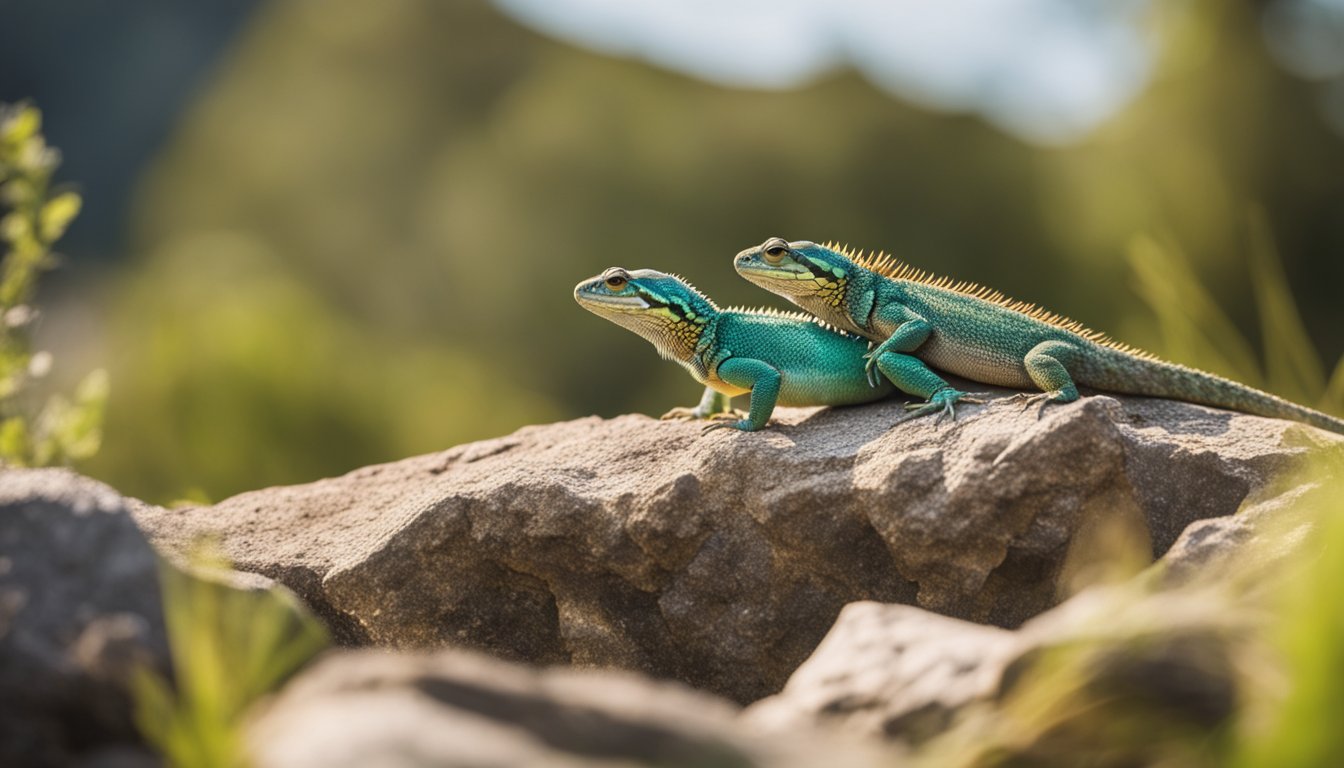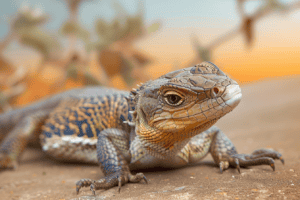Lizards are the sprightly performers of the reptile world, especially those that bask in the sunshine.
Imagine them as little solar panels on legs; these creatures absolutely thrive under the warm rays of the sun.
These sun-loving lizards use the energy from our nearest star to heat their bodies, which helps them stay active.
When the sun climbs high, they scurry out from their hiding spots to soak up the warmth.
This isn’t just a lazy sunbathing session—it’s crucial for their survival.
The warmth of the sun kick-starts their metabolism, allowing them to zip around in search of food and escape from predators.

You may find it fascinating that not all lizards love sunlight in the same way.
Some prefer the early morning rays to get a quick start to the day, while others might be late risers, choosing the midday sun for their solar recharge.
Each species has its own unique routine, which is carefully tuned to its environment and lifestyle.
For example, while one lizard may be darting across hot desert sands, another could be leisurely navigating a lush rainforest canopy.
Despite these differences, they all share the sun as a common ally.
Lizards are not just sun worshippers; they are also masters of camouflage and speed.
Some can change color to blend into their surroundings, disappearing right before your eyes.
Others can run so fast on their hind legs that they almost seem to be dancing on the water’s surface!
These remarkable adaptations make lizards intriguing subjects for anyone curious about nature.
So, let’s take a closer look and uncover some lively facts about these energetic reptiles that celebrate life under the sun.
Diverse Habitats of Sun-Loving Lizards

Sun-loving lizards are a versatile bunch, thriving in a range of environments from the scorching sands of deserts to the leafy green canopies of forests.
Let’s take a peek into the habitats where these creatures bask in the warmth of the sun.
Desert Dwellers
In the sprawling deserts, where the sun reigns supreme, lizards such as the iconic Gila Monster and the swift Sand Lizard have made their home.
They have adapted to the intense heat and scarce water supplies of habitats like the Sahara and Sonoran deserts.
The Sand Lizard, for example, can dance across the sand at lightning speeds, its heat-proof scales glistening in the sunlight.
These desert denizens often seek refuge underground during the hottest part of the day, emerging during morning or late afternoon when the sun’s rays are kinder.
Forest Foragers
Contrasting the arid deserts, forests offer a lush, humid retreat for a different set of sun-loving lizards.
The verdant Green Iguana and the adept Chameleon relish the dappled sunlight that filters through the leaves.
The forest floor and the canopy above provide rich hunting grounds full of insects and other small prey.
Chameleons specialize in stealth, using their unique ability to change color and blend with the environment to sneak up on unsuspecting insects.
Iguanas, often found lounging on a sun-drenched branch, will leap into the water to escape predators, showcasing their versatility within their forest realm.
Physical Characteristics and Adaptations
Let’s embark on a fascinating journey to explore how sun-loving lizards have adapted to thrive under the golden rays of our closest star.
These scaly friends flaunt remarkable physical traits that aren’t just for show—they’re crucial for survival.

Scales and Coloration
Sun-loving lizards are often adorned with a vibrant mosaic of scales that does more than mesmerize the eye.
These scales, made of keratin, protect lizards from the harsh elements and potential predators.
Coloration plays a vital role in their life; it can camouflage them from predators or signal to mates during courtship.
Some lizards can even change their color to better absorb sunlight or cool off, making them the ultimate fashionistas of the reptile realm.
Thermoregulation Techniques
Unlike humans, lizards can’t regulate their body temperature internally.
They rely on thermoregulation to maintain their optimal body temperature.
On a chilly morning, have you seen a lizard basking on a sunlit rock?
They’re soaking up the warmth, since they’re ectotherms, and they need that sunbath to kickstart their day.
When it gets too hot, these clever critters find shade or burrow into cool soil.
It’s their natural way of using their environment to stay comfortable—no air conditioning needed!
Behavioral Traits of Sun-Loving Lizards
Sun-loving lizards exhibit fascinating behaviors that help them thrive in their warm environments.
From the way they interact with other lizards to their hunting strategies, they’ve adapted superbly to capitalize on the sunny habitats they occupy.
Social Interactions
These creatures often engage in complex social behaviors, which may include a myriad of displays and postures.
For instance, many species use body language to communicate with each other, such as nodding or bobbing their heads to establish dominance or readiness to mate.
Territorial disputes are not uncommon, where they may puff up their bodies or flair out their dewlaps—brightly colored skin under the throat—to appear larger and more menacing to potential rivals.
Hunting and Diet
When it comes to feeding, sun-loving lizards are predominantly carnivorous, and their diet primarily consists of insects, spiders, and sometimes even smaller lizards.
They are opportunistic hunters, which means they often catch their prey by surprise.
Visual hunters, these lizards rely on their acute eyesight to detect movement before darting at lightning speeds to snatch their next meal.
Some species have developed a sit-and-wait strategy, where they remain motionless for long periods, blending into their surroundings until an unsuspecting insect wanders too close.
Conservation Status and Human Impact

Lizards are as fascinating as they are diverse, but their existence is often threatened by human activities.
Understanding their conservation status and the impact we have can help safeguard these sun-loving creatures.
Threats to Lizard Populations
Many lizard species are facing challenges that threaten their survival.
Habitat destruction is a considerable threat, as forests are cleared and deserts are altered, leaving lizards without their homes.
Pollution can also be detrimental, contaminating the insects lizards feed on and the water sources they drink from.
Climate change alters temperatures and weather patterns, which can disrupt the delicate balance that lizards need to thrive.
Some specific facts include:
- Habitat Loss: The deforestation rate, which significantly impacts lizards, was 10 million hectares per year between 2015 and 2020.
- Pollution: Pesticides used in agriculture can reduce insect populations by up to 75%, depriving lizards of their food sources.
- Climate Change: A predicted increase of 1.5°C in global temperatures may cause significant changes in lizard reproductive cycles and survival rates.
Conservation Efforts
Conservationists and herpetologists work tirelessly to protect lizards.
They create protected areas where lizards can live without the threat of human development.
Breeding programs also ensure the survival of certain endangered species.
Environmental laws and regulations aim to curb pollution and deforestation, thereby protecting lizard habitats.
Did you know that:
- Protected Areas: Over 202,000 square kilometers of land have been designated as protected areas for reptiles globally.
- Captive Breeding: The San Diego Zoo has successfully bred over 50 species of lizards in captivity, aiding their conservation.
- Legislation: Laws like the Endangered Species Act in the United States protect over 200 species of reptiles, including numerous lizards, from extinction.
By learning about these scaly friends and the challenges they face, one can develop a deeper appreciation for the role they play in our world and the efforts needed to protect them.
Frequently Asked Questions

Exploring the sunny lives of lizards opens a window into their world.
Understand how sunlight plays a pivotal role in their daily routines and survival with these engaging insights.
Why do lizards bask in the sun, and how does it help them?
Imagine feeling sluggish in the morning and then, like a lizard, seeking out a warm sunny spot to recharge.
Lizards bask in the sun to absorb heat, which energizes them and aids in digestion.
This ritual is essential as they are cold-blooded and rely on external heat sources to regulate their body temperature.
Can you describe a day in the life of a sun-loving lizard?
A sun-loving lizard’s day often begins with a leisurely stretch in the early morning sun. They use the warm rays to kickstart their metabolism.
During the hottest part of the day, they might seek shade or burrow to stay cool, emerging in the afternoon for more sunbathing and hunting.
What kind of habitat is ideal for most lizards that enjoy sunlight?
A lizard that thrives in sunlight often prefers habitats with ample basking spots, like rock faces, branches, or desert plains.
These sunny environments not only provide heat but also offer opportunities to hunt for insects and other small prey that are drawn to the warmth.
How does the sun impact the health and behavior of lizards?
The sun not only warms lizards up for their daily activities but also enables the synthesis of vitamin D in their skin, crucial for bone health.
With enough sunlight, their immune system is bolstered, and their mood improves, making them more active and alert.
What adaptations help lizards thrive in sunny environments?
Lizards have evolved with features like scaly skin that minimizes water loss in the heat and varied coloring that can either absorb or reflect sunlight.
Some can even expand their ribcage, increasing their surface area to soak up more of the sun’s warmth.
In what ways can lizards regulate their body temperature in the sun?
Lizards have a range of strategies to keep cool, including changing location from sunny to shaded areas, alteration in body posture to expose less of their body to the sun, and in some cases, altering their breathing patterns to dissipate heat.









